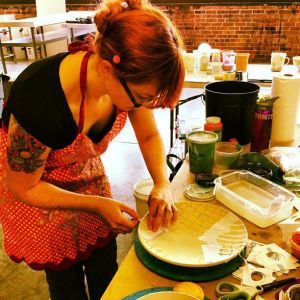 I am pleased to announce that this month’s potter is the super-fabulous Meredith Host! Meredith and I met at The School for American Crafts (at RIT) when we were both studio residents during the 2002-2003 school year. Hard to believe that was over ten years ago…yikes!
I am pleased to announce that this month’s potter is the super-fabulous Meredith Host! Meredith and I met at The School for American Crafts (at RIT) when we were both studio residents during the 2002-2003 school year. Hard to believe that was over ten years ago…yikes!
It’s been a treat watching Meredith’s work evolve over the years. I have many pieces of hers from our time at RIT and I just recently purchased one of Meredith’s current works from the Schaller Gallery. I’m in awe of the layered imagery in this new tumbler I own…the amount of depth Meredith is able to acheive with seemingly flat colors and patterns is remarkable.
For those who know Meredith, her work is indeed a reflection of her personality…full of life, colorful, playful, cheerful and refreshing. Whenever I open the cupboard and see her pots, they put a smile on my face…and using them truly does heighten the dining experience.
For more info about Meredith and her work, visit the links listed at the end of the post. Enjoy the interview!
How did you first get involved in ceramics?
I started taking ceramic classes when I was 11 at a local art center where my mom taught printmaking & painting. Her friend was the ceramics teacher, so she signed me up. Ceramics became my favorite after school activity – and I ended up going to a college prep high school that had an emphasis in art. It had an amazing ceramics studio (although I didn’t really realize that at the time). By the end of high school I was taking 2 hours of ceramics vs. taking any free hours. Ceramics became the thing I couldn’t live without.
Can you briefly describe your background and education?
I grew up in Detroit Rock City in a household that was very supportive of the arts. My mom is a painter/printmaker and has helped run a co-op gallery for over 20 years. I ended up going to Kansas City Art Institute for undergrad and finished my BFA in 2001. Then I moved around a bit to various ceramic studio opportunities such as The School for American Crafts at RIT and Watershed Center for the Ceramic Arts. I went to The Ohio State University for grad school and finished my MFA in 2008. I’ve lived in Kansas City, MO since finishing grad school.
How do you feel that your formal education prepared you for your career in ceramics?
When I graduated from KCAI, I felt confident in my making skills/craftsmanship. They instilled a great work ethic, which has certainly helped me along the way. I still feel guilty at times when I’m not in the studio! My time at OSU helped me figure out how to hone my skills and make a cohesive body of work. Also, grad school gave me the confidence to make the move into working full time in the studio. It was a scary step, but I can’t imagine doing anything else now.
 Every summer through high school and college I worked as a bookkeeper for my family’s sand and gravel business in Detroit. Overall this office background has definitely helped me navigate self-employment. In theory I should be AMAZING at all the paperwork associated with having a business…but I admittedly am not the best at staying on top of it!
Every summer through high school and college I worked as a bookkeeper for my family’s sand and gravel business in Detroit. Overall this office background has definitely helped me navigate self-employment. In theory I should be AMAZING at all the paperwork associated with having a business…but I admittedly am not the best at staying on top of it!
You’ve been awarded numerous residencies over the course of your career? Can you talk a little bit about how they impacted your career path?
Being at RIT helped me bring more of my personality into my work and develop my own artistic voice. I like referring to my time there as “fake grad school”. Also while in Rochester, I assisted Julia Galloway in her studio. I learned a ton about the business side of the job and saw the reality of what it would take to be a studio potter. Hard work but worth it!
At Watershed I was the Salad Days artist, which meant designing and producing 500 plates for their annual fundraiser. This project was challenging and helped me figure out efficiency in my making process.
I’ve had a few post grad school short term residencies: a factory residency at Dresdner Porzellan Manufactory in Germany, a Surface Forum at Arrowmont School of Arts and Crafts, and an Artist Invite Artist session at Watershed. These short term residencies have helped me get out of my normal studio routine, spice things up a bit, and take some chances with my work.
And, of course, a huge impact of residencies has been meeting and networking with so many amazing people!
Like many people, you took significant time between undergraduate and graduate school. What made you decide to attend graduate school?
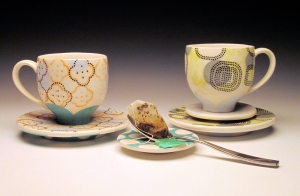 Grad school was always a personal goal; I knew I would go, but I just needed to figure out when would be the right time. I developed a body of work during my time at RIT and Watershed, and this was the work I used to apply to grad school. At that point, I knew I needed the work to be pushed. I felt I had stalled in my making/designing process and craved some critical feedback. In addition, the year before grad school I was working 3 jobs on top of working in my studio. Honestly, I was very much ready to hunker down and focus on JUST making and taking my work to the next level. I only applied to 2 schools because I thought they were the only programs that made sense for me. I attended Ohio State because the work coming out of the program had a sense of quirkiness to it. It’s not necessarily a “pottery” school, but I knew the professors there would push my work/creative process in interesting ways. I think having some life experience after undergrad and waiting to attend grad school was one of the best decisions I ever made.
Grad school was always a personal goal; I knew I would go, but I just needed to figure out when would be the right time. I developed a body of work during my time at RIT and Watershed, and this was the work I used to apply to grad school. At that point, I knew I needed the work to be pushed. I felt I had stalled in my making/designing process and craved some critical feedback. In addition, the year before grad school I was working 3 jobs on top of working in my studio. Honestly, I was very much ready to hunker down and focus on JUST making and taking my work to the next level. I only applied to 2 schools because I thought they were the only programs that made sense for me. I attended Ohio State because the work coming out of the program had a sense of quirkiness to it. It’s not necessarily a “pottery” school, but I knew the professors there would push my work/creative process in interesting ways. I think having some life experience after undergrad and waiting to attend grad school was one of the best decisions I ever made.
What is the inspiration for your pieces? How do you come up with new ideas? Can you walk us through your creative process when coming up with new forms/ideas?
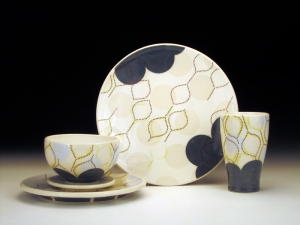 I’ve worked with a few forms for a while now and each year I think they become more refined. It’s been a slow evolution, but as my design eye changes, the forms are tweaked ever so slightly. I find a lot of my refining is done during the trimming process…that’s when I feel like I can really get that proper profile line. I choose to make simple, clean, and smart forms…forms that feel good to hold or to use. Ultimately I want my work to be easily used for what it is intended.
I’ve worked with a few forms for a while now and each year I think they become more refined. It’s been a slow evolution, but as my design eye changes, the forms are tweaked ever so slightly. I find a lot of my refining is done during the trimming process…that’s when I feel like I can really get that proper profile line. I choose to make simple, clean, and smart forms…forms that feel good to hold or to use. Ultimately I want my work to be easily used for what it is intended.
I’m not much of a sketcher when it comes to making new forms. Maybe a quick line representing a profile, or a really basic line drawing (and probably completely wrong perspective), but that’s it as far as 2D goes. Usually most of my sketching happens on the wheel. I can visualize best in 3D.
I’m inherently drawn to the surfaces of your work not only because of the colors and patterns you choose, but because of the amount of depth you’re able to achieve. Can you briefly describe your surface processes and inspiration?
I decorate my work using paper stenciling and thermofax screen-printing with underglaze to add most of my layers. Almost of all the color and pattern is put on the piece before the bisque firing, but one last final iron oxide decal layer or china paint decal layer is applied and fired after the glaze firing. Each piece is fired at least 3 times.
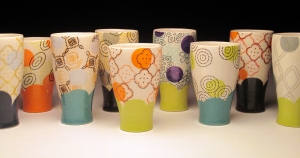 My forms are simple and clean to contrast the complex surface decorations. Although my formal language is minimal, my approach to surface decoration is “more is more.” I layer these designs and decals to make an intricate, complex surface that would not be possible with only a single layer of pattern. It is a challenge to know when a piece is finished, because my tendency is to fill all the blank space. Decorating is my driving force at the moment; it’s all I want to do!
My forms are simple and clean to contrast the complex surface decorations. Although my formal language is minimal, my approach to surface decoration is “more is more.” I layer these designs and decals to make an intricate, complex surface that would not be possible with only a single layer of pattern. It is a challenge to know when a piece is finished, because my tendency is to fill all the blank space. Decorating is my driving force at the moment; it’s all I want to do!
My patterns come from my collection of what I like to call “overlooked domestic patterns” aka toilet paper and paper towel patterns. I’ve been collecting swatches of these subtle dimple decorations for over 10 years. I’m taking these throwaway everyday items/patterns and turning them into something permanent and still meant for daily use.
Currently, you produce two separate “lines” of work. One that is more commercially manufactured and one that is handmade. Can you talk a little bit about the differences between these two “lines” of work and how you decided to develop both?
“foldedpigs dinnerware” is what I call my commercial/retail line, and “Meredith Host” is my studio artwork. I started the foldedpigs business completely by accident during 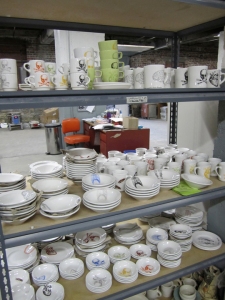 grad school at OSU. Long story short, I made a few decaled restaurant dishes for a clay club sale to help contribute to our visiting artist fund. There was a crazy snowstorm and school was cancelled the day of our sale. I had just started an etsy site to try to sell older studio work, so I listed the repurposed restaurant dishes in my shop. They sold quickly and I started to receive requests for more. The new line began supplementing my costs during grad school. Upon graduating, the head of my committee, Rebecca Harvey, gave me the encouragement to continue this endeavor, as there was obviously a demand for my product. I embraced foldedpigs and ventured into working full time in the studio, splitting my time between my studio artwork and commercial line.
grad school at OSU. Long story short, I made a few decaled restaurant dishes for a clay club sale to help contribute to our visiting artist fund. There was a crazy snowstorm and school was cancelled the day of our sale. I had just started an etsy site to try to sell older studio work, so I listed the repurposed restaurant dishes in my shop. They sold quickly and I started to receive requests for more. The new line began supplementing my costs during grad school. Upon graduating, the head of my committee, Rebecca Harvey, gave me the encouragement to continue this endeavor, as there was obviously a demand for my product. I embraced foldedpigs and ventured into working full time in the studio, splitting my time between my studio artwork and commercial line.
I always knew that I wanted to work full time in my studio and having foldedpigs around has allowed me to do so for the last 5 years. Eventually, I’d love to just be making my work, but for now foldedpigs helps supplement my income. My main challenge is the time balance in the studio. I’ve been able to streamline foldedpigs that I spend less time with it but am able to produce just as much (if not more) than I used to.
I do try to keep the two aspects of my studio separate: It doesn’t bother me that people know I’m the designer and producer of foldedpigs, but I’d prefer it not be referred to as my art. Sometimes it’s hard to escape that, but I make an effort to distinguish between the two. I have made a conscious choice to not sell my artwork and foldedpigs in the same places, as part of the separation.
You’ve been successful with both lines of work by reaching a wide audience (one that exceeds the ceramics community). How do you go about marketing each line? What are the differences in target audience/etc.? Is there any crossover?
I’ll be honest…I lucked out with foldedpigs. I started an etsy shop in the early days of etsy (2007) so I had a decent amount of exposure right away. Within 6 months, I was asked to be a featured seller. I went into my 3 day stint of being featured with 125 sales, and at the end of the 3 days, I had 250 sales. Doubling my 6 months worth of sales in 3 days was kind of a big deal and launched foldedpigs into a full fledge business. My exposure on Etsy also opened some doors into product placement in magazines (BUST, Adorn, Country Living, Inked, Everyday with Rachael Ray). Etsy definitely provides a large audience, and most of the shops/boutiques I wholesale with have found me through my shop. I also sell foldedpigs in the indie craft fair circuit, locally here in Kansas City, as well as throughout the country in quite a few cities (Chicago, Brooklyn, Philadelphia, Indianapolis, Columbus, Austin, Los Angeles, and San Francisco).
I’m at the point now where the promotion isn’t just falling into my lap anymore, so I’ve been trying to figure out how social media can work to generate sales with both foldedpigs and my studio work. Websites, blogs, twitter, pinterest, facebook, instagram, mailing lists, etc.etc. There are so many things to update! I was reluctant to start a facebook “like” page, but I’ve found that facebook reaches people pretty quickly. I’m guessing no one is going to look at my website daily/weekly, but they most likely look at their facebook news feed at least once a day. Just a quick example, this past weekend I was a vendor at a one day local indie craft fair. I forgot to tell people about it…until the morning of! I posted an announcement on facebook before I left the house, then in the first couple hours posted a picture on instagram of my set up. I started seeing familiar faces show up and they all said they found out about the show from my status update. Someone else showed up because of my instagram picture…and these quick little announcements turned into sales.
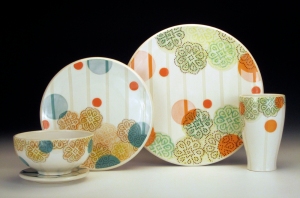 There is definitely a different audience for each line. Foldedpigs is made for an audience that wants something a little bit more edgy than store bought commercial lines. Foldedpigs is easily digestible, and at a much lower price point, which widens its audience. It’s straight forward. Graphically it’s neutral (black, blue & grey on white) so that it can integrate into households easily and match/supplement their pre-existing dinnerware. It’s all uniform and stacks nicely in a cupboard.
There is definitely a different audience for each line. Foldedpigs is made for an audience that wants something a little bit more edgy than store bought commercial lines. Foldedpigs is easily digestible, and at a much lower price point, which widens its audience. It’s straight forward. Graphically it’s neutral (black, blue & grey on white) so that it can integrate into households easily and match/supplement their pre-existing dinnerware. It’s all uniform and stacks nicely in a cupboard.
The audience for my artwork is interested in handmade dinnerware and is okay with having a piece or two that does not match the rest of their cupboard. They are willing to invest in a higher price point handmade object and appreciate what goes into making the object.
How did you arrive at the decision to settle and start up a studio? What were your must-haves when choosing a studio and location?
I chose to move back to Kansas City after grad school. I was sick of moving around so much and was ready to be in one place to try my hand at working full time in the studio. Kansas City has a really supportive art community and it’s affordable. I knew I would be able to live here AND have a separate studio. I’ve found through the years that I’m happier when I’m around others while working vs. being alone.
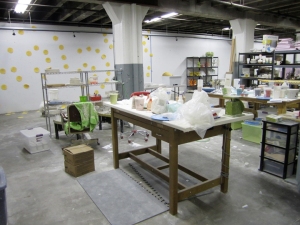 Right now my studio situation is amazing; I share a warehouse space with Rain Harris and Paul Donnelly. Because we are in a large warehouse, I’m able to have 2 separate spaces for my work and for foldedpigs, which has allowed for mental breathing space. I’ve found that I’m much more productive with the two projects separated. We have enough space to have a plaster area for mold making, a photo set up, woodshop, packing area, and packing materials storage.
Right now my studio situation is amazing; I share a warehouse space with Rain Harris and Paul Donnelly. Because we are in a large warehouse, I’m able to have 2 separate spaces for my work and for foldedpigs, which has allowed for mental breathing space. I’ve found that I’m much more productive with the two projects separated. We have enough space to have a plaster area for mold making, a photo set up, woodshop, packing area, and packing materials storage.
I have to say, the photo set up is a must-have…being able to document work easily and at any point in the day has been awesome. Also, our studio is right below Crane Yard Clay Supply, so it couldn’t be more convenient. If I’m out of plaster or a specific color of underglaze, I just have to walk upstairs. I feel incredibly spoiled.
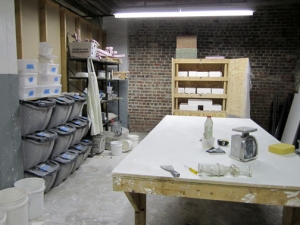 In our same warehouse complex, the new Red Star Studios and Gallery are moving in. I’m really excited to be a part of the amazing clay/art community that is developing.
In our same warehouse complex, the new Red Star Studios and Gallery are moving in. I’m really excited to be a part of the amazing clay/art community that is developing.
What does a typical workday look like for you? How much do you spend on marketing vs. making?
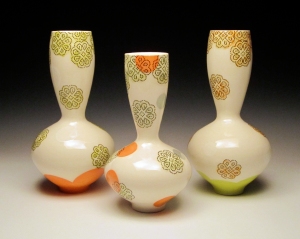 I suppose there’s a rough outline of what my typical day looks like… I’m usually up around 8:30, and head to studio by 10. I enjoy taking my time in the morning; making breakfast, taking my sweet little beast Olive for a walk, checking email, plotting out the day in studio, etc. Usually the first order of business when I get to the studio is to pack up any orders from Etsy and get them ready to ship. After that, it’s work time. I’m very deadline driven, so deadlines dictate what and when I’m making. I go through waves of making, decorating, glazing, decaling… it’s a bit rare that all of that happens simultaneously. The balance between foldedpigs and my studio art work is a challenge. If a random foldedpigs order comes in, I’ll run over to my other section of the studio and frantically decal for a couple of hours. I usually finish up around 5:30-6:30 and head to the gym, afterwards, I go home to make dinner. In the evening I usually spend a couple hours on the computer dealing with paperwork, emails, updating social media stuff, etc.etc. If I have a really pressing deadline then I’ll skip the gym and go back to the studio after dinner to work for longer. I work half days Saturday & Sunday, but once again, if there’s a pressing deadline, the amount of hours in the studio grow exponentially. Then, of course, there’s the occasional day that is devoted to all computer work and paperwork. Ugh…not my favorite type of day.
I suppose there’s a rough outline of what my typical day looks like… I’m usually up around 8:30, and head to studio by 10. I enjoy taking my time in the morning; making breakfast, taking my sweet little beast Olive for a walk, checking email, plotting out the day in studio, etc. Usually the first order of business when I get to the studio is to pack up any orders from Etsy and get them ready to ship. After that, it’s work time. I’m very deadline driven, so deadlines dictate what and when I’m making. I go through waves of making, decorating, glazing, decaling… it’s a bit rare that all of that happens simultaneously. The balance between foldedpigs and my studio art work is a challenge. If a random foldedpigs order comes in, I’ll run over to my other section of the studio and frantically decal for a couple of hours. I usually finish up around 5:30-6:30 and head to the gym, afterwards, I go home to make dinner. In the evening I usually spend a couple hours on the computer dealing with paperwork, emails, updating social media stuff, etc.etc. If I have a really pressing deadline then I’ll skip the gym and go back to the studio after dinner to work for longer. I work half days Saturday & Sunday, but once again, if there’s a pressing deadline, the amount of hours in the studio grow exponentially. Then, of course, there’s the occasional day that is devoted to all computer work and paperwork. Ugh…not my favorite type of day.
I’m not sure what the exact time split between making/marketing would be, maybe 80 making/20 marketing? I’m counting paperwork, emails, and office type stuff as marketing even though it might not technically be. And I might be underestimating the marketing percentage…I spend A LOT of time on the computer.
What is the one studio tool you can’t live without? Why?
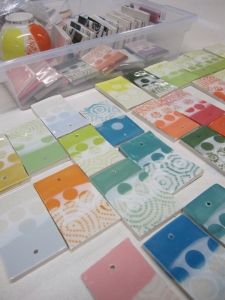 Because my work is really layered, there’s not just one thing that would make or break it. Taking something away would change my work a bit here and there. So I’m going to go with a cheesy answer of… my hands, creativity, and drive.
Because my work is really layered, there’s not just one thing that would make or break it. Taking something away would change my work a bit here and there. So I’m going to go with a cheesy answer of… my hands, creativity, and drive.
Also, if you took away my computer, thermofax machine, underglazes, wheel, and kiln, I would be really sad.
You’ve had an Etsy site for quite a few years now. How has your experience on Etsy helped your career?
Etsy has certainly helped my foldedpigs line get off its feet and grow for the past 6 or so years. I mentioned this before, but I have had product in magazines and started wholesaling with shops/boutiques all because of my Etsy shop. And ultimately, Etsy helps pay my bills and allows me to be in the studio full time.
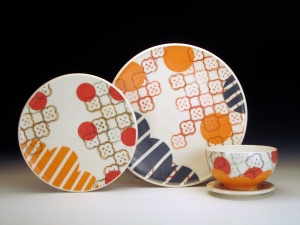 My “Meredith Host” shop is rather new, so I haven’t seen much impact quite yet. I need to start being a bit more proactive and allocating more work for this shop.
My “Meredith Host” shop is rather new, so I haven’t seen much impact quite yet. I need to start being a bit more proactive and allocating more work for this shop.
Finally, what advice would you give to aspiring potters who are looking to set up a studio and make pots for a living?
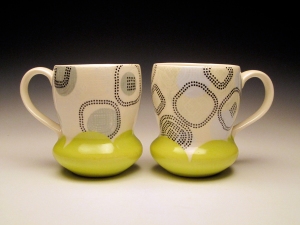
Be organized. Don’t forget to document. Work your ass off. Make, make, make, make, and MAKE some more!
To discover more about Meredith and her work, check out the following:
Meredith links:
Website: www.meredithhost.com
Shop: meredithhost.etsy.com
Facebook: www.facebook.com/MeredithHost
Instagram: instagram.com/meredithhost#
Studio blog: meredithhost.blogspot.com
foldedpigs dinnerware links:
Shop: foldedpigs.etsy.com
Facebook: www.facebook.com/foldedpigs
Twitter: twitter.com/foldedpigs
